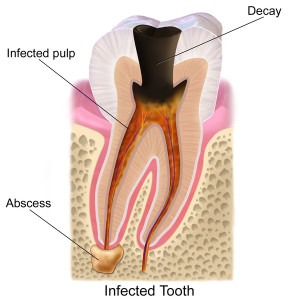Root Decay Treatment
 Root decay presents itself more frequently as one ages, where gum recession and periodontal disease tend to co-exist and expose the roots of teeth. The site for root caries is most commonly found at the receded gum margin, where plaque tends to accumulate most easily and begins destructing the exposed root surface beneath. The elderly often suffer dry mouth, which further enhances the growth of a carious lesion on the root.
Root decay presents itself more frequently as one ages, where gum recession and periodontal disease tend to co-exist and expose the roots of teeth. The site for root caries is most commonly found at the receded gum margin, where plaque tends to accumulate most easily and begins destructing the exposed root surface beneath. The elderly often suffer dry mouth, which further enhances the growth of a carious lesion on the root.
Treating root caries involves first diagnosing the extent of caries with the help of radiographs, followed by removal of the decayed surfaces with hand instruments. The destructed root surface may then need to be re-contoured in order to retain a filling material better and to allow more efficient brushing. A filling material, preferably a Glass Ionomer Cement (possessing the unique fluoride storage ability) is used to fill the cavity under strict isolation protocols.
If the extent of the caries has reached the pulp, the root may need root canal treatment and if it has spread too far below the gum margin, restoration becomes impossible and it may need to be extracted. In order to completely avoid root decay, maintaining a good oral hygiene regime is essential and any systemic condition in the elderly that leads to high blood sugar or dry mouth needs to be dealt with accordingly.
Receding gums reveal a tooth’s roots that don’t have the same hard enamel coating found on teeth. The roots of our teeth are covered by cementum, which joins the tooth to the jawbone. Plenty of dental problems come with the exposure of cementum — it’s yellow in color, making for a less attractive smile. Cementum does not protect the tooth like enamel and these exposed roots are susceptible to further decay.
What’s worse, root decay is good at hiding out. Root decay lurks along the gum line or in between teeth where it’s hard to detect. Although you may not feel any pain, these are some telltale signs to look for:
- Discoloration of the tooth at the gum line.
- Receding gums allowing a yellowish part of the tooth to show.
- Notches on the tooth where it meets the gums.
Root decay also increases your chances of needing a root canal depending on the severity of the decay. A dental cavity on the root of the tooth has more chances of affecting the pulp within your tooth, so it’s important to treat root decay before it has a chance to spread.
The only accurate way to detect and locate decay between teeth is by X-ray.





